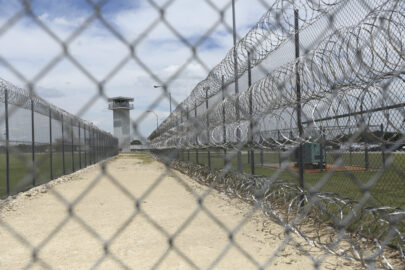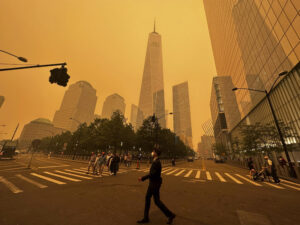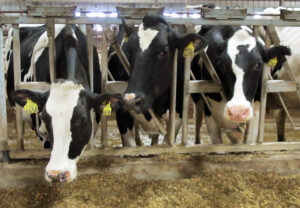Is It Time for a National Cooling Standard?
Duke University experts say policies, institutions must change to address dangerous heat exposure. As record temperatures continue to climb, extreme heat causes more problems for those working outside without a way to cool down Photo: Clayton Henkel / NC Newsline.
As record temperatures continue to climb, extreme heat causes more problems for those working outside without a way to cool down Photo: Clayton Henkel / NC Newsline.
Heat, humidity and the quest for air conditioning are a part of every summer. But Ashley Ward believes this summer is a wake-up call for many Americans.
Ward directs the Heat Policy Innovation Hub at Duke University’s Nicholas Institute for Energy, Environment & Sustainability. Her work focuses on the health impacts of climate extremes and community resilience.
“We’re not talking about a heat wave anymore,” Ward said in a media briefing Thursday. “We’re talking about a season. We’re talking about a marker of a shift in our heat regime that we need to pay attention to.”
Arizona has recorded 27 days of heat over 110 degrees. People have experienced critical burns from contact with the pavement. Gulf Coast states have experienced thousands of dying fish on their shores. The ocean temperature off Florida this week was similar to that of a hot tub.
And we’re not just breaking the records of daytime temperatures. We are also breaking records overnight.
“We’re talking about a new chronic state of being for heat season,” Ward warned. “And it isn’t unreasonable to think this could quite possibly be the coolest heat season of our lives.”
Beyond those laborers who never get a chance to physically cool down, Ward believes the nation needs rules that address the well-being of institutionalized populations, who are often overlooked.
That’s worrisome news for Dr. J.J. Hoff, an emergency medicine specialist, who has noted a rise in heat-related illnesses in the emergency department at Duke University Hospital.
Hoff, an assistant professor in the Department of Emergency Medicine at Duke’s School of Medicine, said workers exerting themselves outdoors as well as the vulnerable populations can easily succumb to triple-digit heat unless they take precautions.
“What we tend to then see is progression of exposure to heat that shuts the body down, right? You might feel a little bit lightheaded, feel a little woozy, feel kind of out of it. As soon as you can get out of that heat and get some hydration on board, you feel a little bit better,” Dr. Hoff explained.
But when it progresses to heat stroke, doctors will see evidence of organ dysfunction.
Ward believes it’s time to broaden the scope of who is considered vulnerable.
“It’s not only about farmworkers in North Carolina and throughout the Southeast, manufacturing is located in rural areas,” Ward said. “It is not unusual to have indoor manufacturing temperatures exceed 90 degrees during the day, with populations that return home and live in either energy inefficient housing or do not have access to any cooling in their homes.”
Beyond those laborers who never get a chance to physically cool down, Ward believes the nation needs rules that address the well-being of institutionalized populations, who are often overlooked.
“I noticed a couple of weeks ago in Alabama, for example, it remained over 87 degrees overnight for several days there. Only four of their 26 prisons are air conditioned,” said Ward.
North Carolina’s General Assembly set aside $30 million two years ago to upgrade 40 prisons without cooling systems. As NC Newsline reported in late June, about 63% of all prison beds are in air-conditioned housing units. About 15,000 of the 30,700 people in prison do not have air conditioning.
Likewise, there is no federal requirement that nursing homes and long-term care facilities be air conditioned.
In North Carolina, state law stipulates indoor temperatures at these facilities cannot exceed 81 degrees.
“But if you think about 81 degrees to a population that has a lot of chronic illnesses, take a lot of medicines that make it difficult for their body to process heat, that’s really important,” said Ward.
There is also no cooling requirement for public housing or low-income housing.
“So, this is women, children, the disabled. We really need to think holistically about who is at risk, how they’re at risk, and at what thresholds of risk, so that we can develop the appropriate strategies for response,” Ward stressed.
The heat index often mentioned in a local weather forecast may actually be an under-representation of conditions.
One strategy that Jordan Clark would like to see implemented is better forms of measurement beyond the standard heat index most are familiar with.
Clark is a postdoctoral associate for the Heat Policy Innovation Hub and the Water Policy Program.
Clark believes WetBulb Globe Temperature is a more accurate measure of heat stress — taking into account air temperature, humidity, the impact of wind blowing across our bodies, as well as the impact of the heat coming from the sun and the surface below us.
The heat index often mentioned in a local weather forecast may actually be an under-representation of conditions.
“Those sensors are shielded from the sunlight and thus are basically representing what the conditions are in the shade,” said Clark.
Clark also recommends high schools develop sport-specific guidelines based on heat stress levels that outline safe practices for hydration, work-to-rest ratios, clothing, equipment use and heat acclimatization.
Onsite temperature measurements can also help improve heat protocols for student athletes.
Better measurements and better forecasting are especially helpful when there’s no reprieve from the extreme heat.
In Arizona, there have been several days this summer where it remained above 90 overnight.
“What’s extraordinary about this heat season is that in fact we’re seeing across the Sunbelt region, incredibly high daytime temperatures associated with higher-than-normal rates of humidity and then persistently high overnight temperatures,” cautioned Ward. “This is in fact the worst-case scenario for health outcomes.”
If you do begin to feel sick from the heat, Dr. Hoff recommends changing your environment and finding a cooler place.
“First and foremost, hydration, hydration, hydration, people need to stay hydrated,” said Hoff. “Our body’s response to extreme heat is to sweat and we lose fluid that way.”
And it doesn’t need to be a fancy sports-energy drink.
“The answer is always water. Start with water.”
On Thursday, President Biden asked the Department of Labor to issue the first-ever Hazard Alert for heat and to ramp up enforcement to protect workers from extreme heat. The DOL will provide information on what employers can and should be doing now to protect their workers, while helping ensure employees are aware of their rights.
More than 35,000 schools in the U.S. need HVAC system updates.
Beyond enforcement, Ward would like to see a national cooling standard implemented.
More than 35,000 schools in the U.S. need HVAC system updates.
“We have a standard that buildings be heated during the winter up to a certain level. Landlords are required to provide heating for their tenants; schools are required to have heat; prisons…are protected by this heating standard in the U.S. We do not have a like cooling standard, and this is challenging,” she said.
Challenging, but not impossible.
“I want to point out that Scotland County in North Carolina, one of the poorest counties in the state, implemented universal air conditioning in their schools. So, it is possible to do even on a limited budget.”
As for getting through the remainder of this sweltering summer, Dr. Hoff, the emergency room specialist, said don’t underestimate the toll the heat can take.
“You have to be prepared. Take more hydration than you think you will need. Take more breaks than you think you will need.”
Your support matters…Independent journalism is under threat and overshadowed by heavily funded mainstream media.
You can help level the playing field. Become a member.
Your tax-deductible contribution keeps us digging beneath the headlines to give you thought-provoking, investigative reporting and analysis that unearths what's really happening- without compromise.
Give today to support our courageous, independent journalists.







You need to be a supporter to comment.
There are currently no responses to this article.
Be the first to respond.